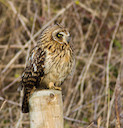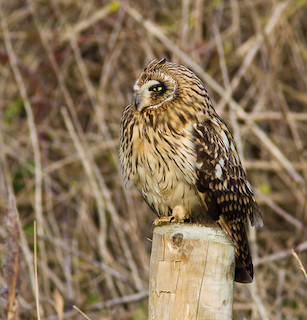 Short-eared Owls often hunt by day, so it’s worth keeping an eye out for them, especially through the winter.
Short-eared Owls often hunt by day, so it’s worth keeping an eye out for them, especially through the winter.
Photo: © Natural England/Allan Drewitt
Scientific name: Asio flammeus
Cornish name: Oula is the general word for an owl.
Conservation status: UK Birds of Conservation Concern, Amber; IUCN Red List, Least Concern.
What to look for:
- Colouring and appearance: Bodies are mottled brown, and the paler underwings are clearly visible in flight. The eyes are yellow and the wings have black bars.
- Size: Length 38 cm, wingspan 102 cm.
- Where: Scotland and northern England in the breeding season; across the UK in winter.
- Call: Hear the alarm call here.
- Similar species: Long-eared Owl.
 If you see an owl flying in the daytime, then there is a pretty good chance it is a Short-eared Owl. Like other owls, this species is mainly nocturnal and crepuscular, but is more frequently seen during daylight hours than any of its cousins as it hunts for its prey. They are an impressive sight, with their agile flight and wide wingspan.
If you see an owl flying in the daytime, then there is a pretty good chance it is a Short-eared Owl. Like other owls, this species is mainly nocturnal and crepuscular, but is more frequently seen during daylight hours than any of its cousins as it hunts for its prey. They are an impressive sight, with their agile flight and wide wingspan.
At rest, maybe perched on a fencepost, their vivid yellow eyes are both striking and intimidating (intimidating to your average small mammal, anyway). They can be hard to spot in a tree or in undergrowth, however: the mottled plumage gives excellent camouflage.
It would be very unusual to spot a Short-eared Owl in the spring and summer down on The Lizard. This is an owl that, in the UK, mainly breeds in Scotland and the north of England. In the cold season, however, the number of breeding birds (between 620 and 2,180 pairs) is significantly increased by overwintering visitors from Scandinavia, Iceland and Russia – there might be anything between 5,000 and 50,000 individuals, with many found in the south of England, including Cornwall.
You might be wondering why there is such a large range in the estimate of the number of breeding pairs. The British Trust for Ornithology has recently been undertaking some research in response to concern that there is a serious decline in the breeding population. In monitoring numbers as part of this study, it was relatively easy to count pairs when feeding their young, but other pairs that have not bred successfully can be harder to find. Add to this natural population fluctuations and the wide range of the owls as they hunt for food, and it can be hard to pinpoint a reliable population figure.
Did you know…?
…There are ten sub-species of Short-Eared Owl: this is one of the most widespread owl species globally. The species we see in the UK is Asio flammeus ssp. flammeus.
…The species name flammeus means, as you can probably guess, flame-like or fiery, in reference to its mottled plumage.
More information and references:
Svensson, L., Mullarney, K., Zetterstrom, D.,1986. Collins Bird Guide, second edition (translated by Christie, D., Svensson, L.). HarperCollins, London.
Published: October 2015
Author: Amanda Scott
Photos: © Natural England/Allan Drewitt
